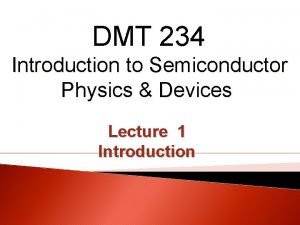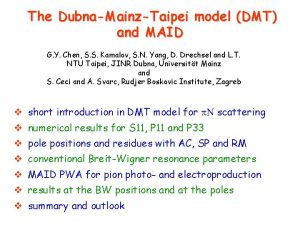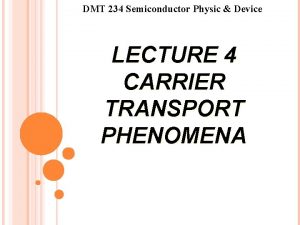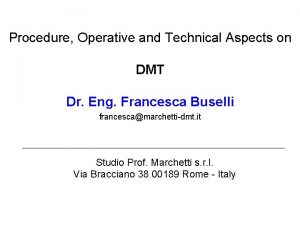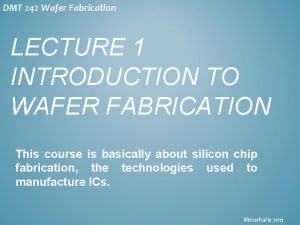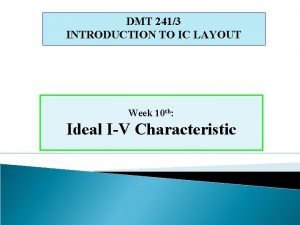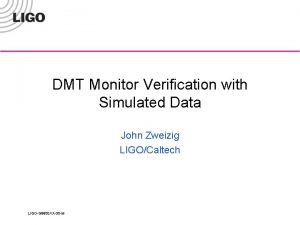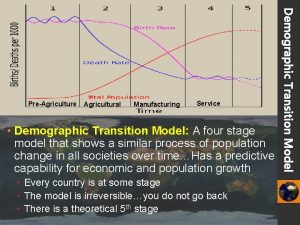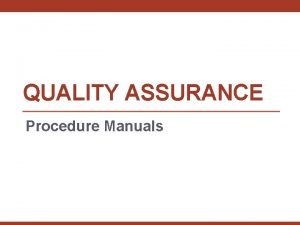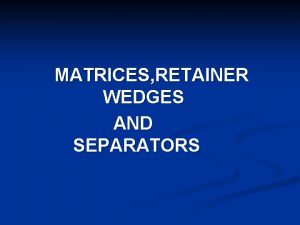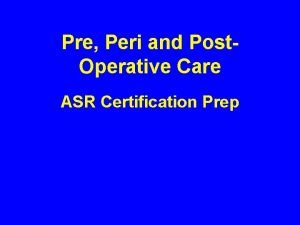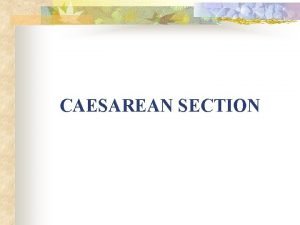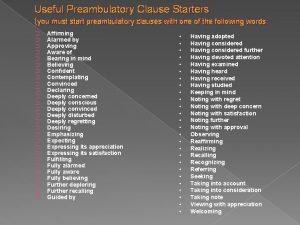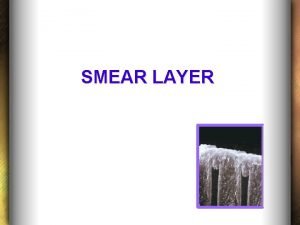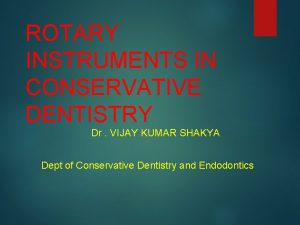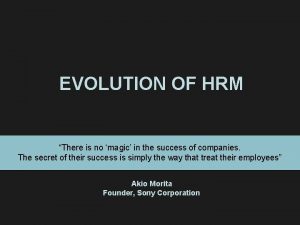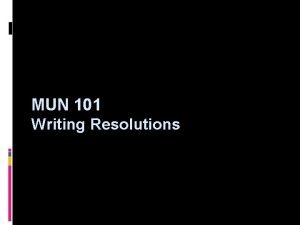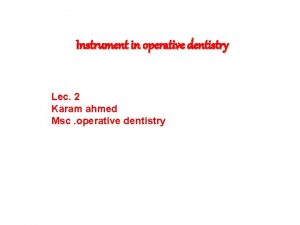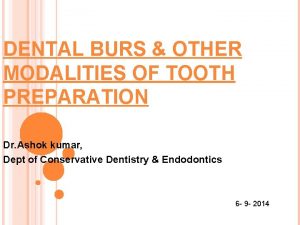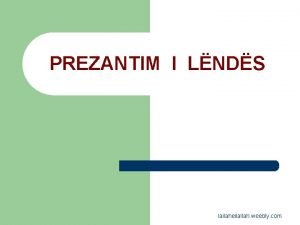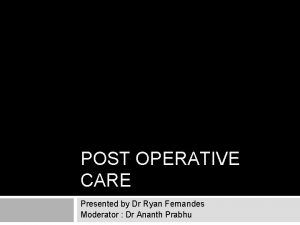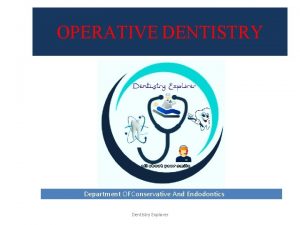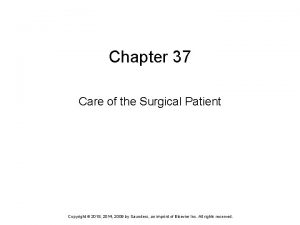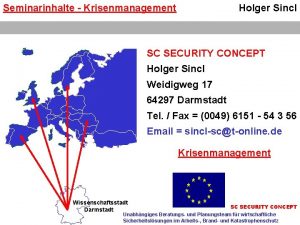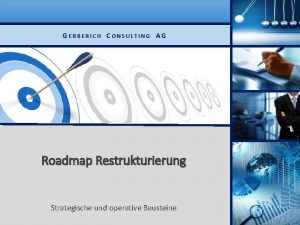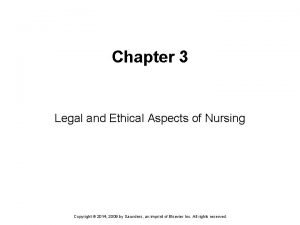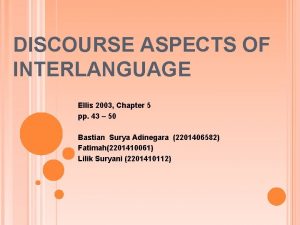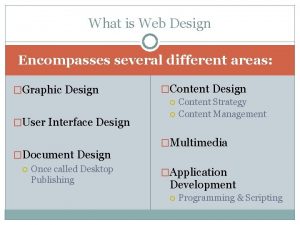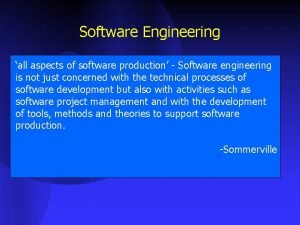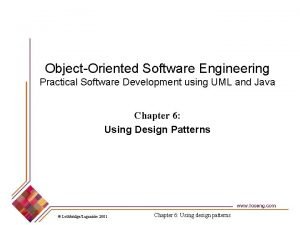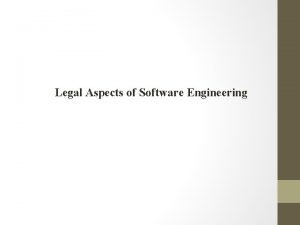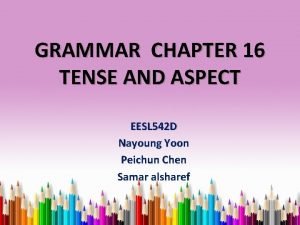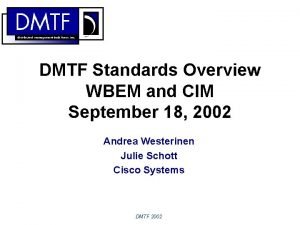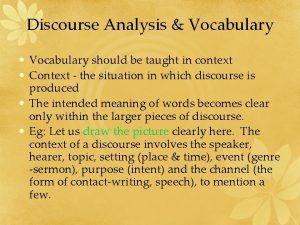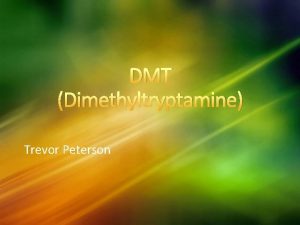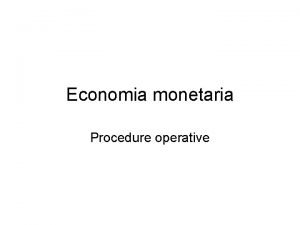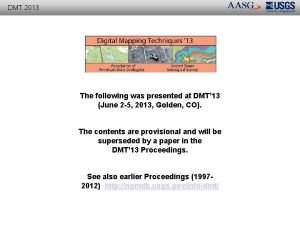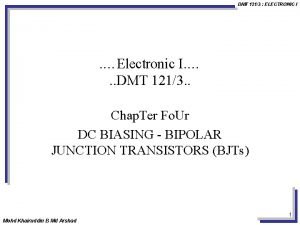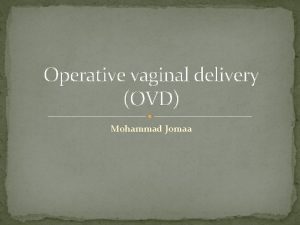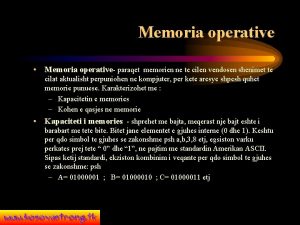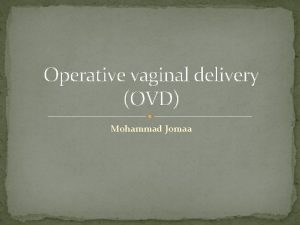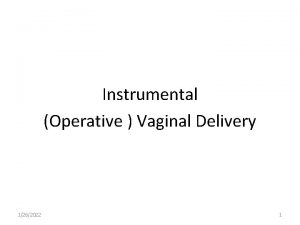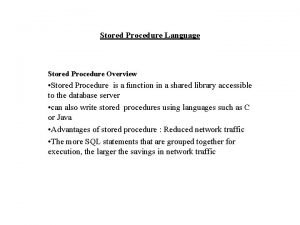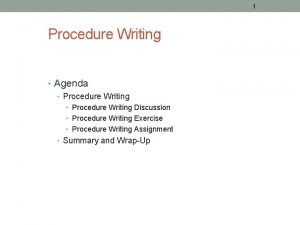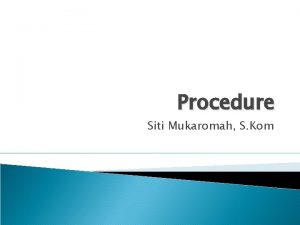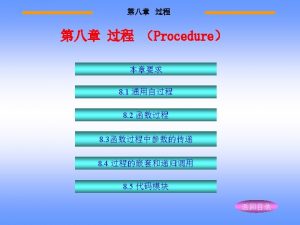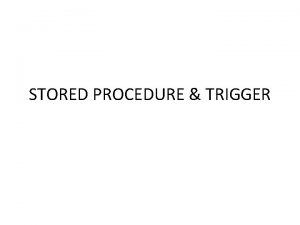Procedure Operative and Technical Aspects on DMT Dr



























































































- Slides: 91

Procedure, Operative and Technical Aspects on DMT Dr. Eng. Francesca Buselli francesca@marchetti-dmt. it Studio Prof. Marchetti s. r. l. Via Bracciano 38 00189 Rome - Italy

1. Background and References; 2. DMT Equipment 3. Test Layout and the Working Principle 4. How to Insert the DMT Blade into soil 5. The Membrane Calibration 6. C-Reading and Dissipation Test 7. Interpretation of the Results 7. 1 Intermediate Parameters (ID, KD, EDMT) 7. 2 Geotechnical Soil Parameters (MDMT, Cu, f, etc. ) 8. Quality Checks and Maintenance

Soil Investigation I. Identification of potential limit states II. Critical parameters essential to the successful completion of the project a. Laboratory testing b. In situ testing c. Previous site investigation or published data d. Back analysis of performance of nearby construction In Situ Testing: when? § Good quality sampling is not possible; § The parameter required cannot be obtained from laboratory test (in situ horizontal stress); § In situ tests are cost effective and quick § Appropriate methods may be able to test large volumes of ground ensuring that the effects of large particle size and discontinuities are fully represented.

In situ Testing Method (Mayne et al. , 17 th Int. Conf. on Soil Mech. and Geotech. Eng. , 2009)

SDMT and SCPTU “. . . In this fast-paced world, a more efficient approach … In particular, the Seismic Piezocone (SCPT) and the Seismic Dilatometer (SDMT). . . offer clear opportunities in the economical and optimal collection of data” “. . . SCPT and SDMT direct-push tests should serve as the basis … in routine daily site investigation practices …” Mayne P. W. , Georgia Institute of Technology, Atlanta, USA (17 th Int. Conf. on Soil Mech. and Geotech. Eng. , Alessandria d’Egitto 2009)

SDMT and SCPT 4° International Conference on Geotechnical and Geophysical Site Characterization, Brazil, September 2012 Ø Total 226 papers: 57 references to SDMT, 40 on SDMT Ø Papers recommending SCPT and SDMT for routine investigation • Robertson (Mitchell lecture): “more efficient and cost effective approach is the utilization of direct-push methods using multi-measurement in-situ devices, such as the seismic cone (SCPT) and the seismic flat dilatometer (SDMT)” • Howi (session report): ‘”The uncertainty [of SPT] is a strong argument in support of the recommendation by Mayne et al. (2009) that the SCPT or SDMT should be used instead of SPT for routine investigations’” • Mlynarek (session report): ‘”Several papers created an excellent foundation for further, global analyses of results from different countries in areas, where CPTU and SDMT/DMT are becoming basic methods for the evaluation of subsoil properties under in situ conditions”’ • De Vincenzi, Cruz, . .

The Flat Dilatometer Test DMT

DMT and SDMT Users Community (>200 in USA) (°) Algeria, Angola, Argentina, Australia, Austria, Bahrain, Bangladesh, Belgium, Bolivia, Bosnia, Brazil, Bulgaria, Canada, Czech Republic, China, Chile, Cyprus, Colombia, Costa Rica, Croatia, Denmark, Ecuador, Egypt, United Arab Emirates, Estonia, Finland, France, Germany, Greece, Guadalupe, Guatemala, Honduras, Hong Kong, Hungary, India, Indonesia, Iran, Israel, Italy, Japan, Korea, Kosovo, Kuwait, Lithuania, Malaysia, Mexico, Netherland, New Zeland, Norway, Oman, Pakistan, Peru, Poland, Portugal, Romania, Russia, Saudi Arabia, Serbia, Singapore, Slovenia, South Africa, Spain, Sri Lanka, Sweden, Switzerland, Taiwan, Thailand, Tunisia, Turkey, United Kingdom, United States of America, Venezuela, Vietnam.

Basic DMT and SDMT references: www. marchetti-dmt. it Website: www. marchetti-dmt. it

Basic DMT and SDMT References: www. marchetti-dmt. it

Basic SDMT References Manuals, Reports … TC 16 (2001). “The DMT in soil Investigations”, a report by the ISSMGE Technical Committee TC 16 on Ground Property Characterization from in-situ testing. European Standards EUROCODE 8 (2007). “Standard Test Method, European Committee for Standardization”, Design Assisted by Field Testing, Flat Dilatometer Test (Part 3 - Section 9), EUROPE. SGF Report (1994). “Recommended Standard for Dilatometer Tests, SGF Report” 1: 95 E, Swedish Geotechnical Society, SWEDEN. Nuove Norme Tecniche per le Costruzioni NTC 08 – CIRCOLARE 02/02/2009 (2009). “Istruzioni per l’applicazione delle Norme Tecniche per le Costruzioni”, sez. C 6. 2. 2, Consiglio Superiore dei Lavori pubblici, ITALY. ISO/TS 22476 -11: 2005(F) (2005). “Geotechnical Investigation and Testing – Field Testing – Flat Dilatometer Test”, (parte 11), FRANCE. Worlwide Standards ASTM (2002 – reapproved 2007). “The standard test method for performing the Flat Dilatometer Test (DMT)” (D 6635 -01), American Society for Testing and Materials, AMERICA. TB 10018 (2003). “In situ Measurement of railway engineering geology”, Ministry of Railway; GB 50021 (2003). “Code for investigation of geotechnical engineering”, Ministry of Housing and Urban-Rural Development; DGJ 08 -37 (2012). “Code for investigation of geotechnical engineering”, CHINA.

DMT Flat Dilatometer Equipment

The DMT Blade Stainless steel blade width: 0. 095 m blade thickness: 0. 015 m Blade : pushing thrust up to 250 k. N membrane diameter: =0. 06 m (Marchetti, 1980)

DMT Test Layout 5 3 6 1. Dilatometer Blade 4 7 2. Push Rods (i. e. CPT) 3. Push Force or dynamic penetration 4. Pneumatic – electric cable 5. Control Box 6. Pneumatic cable 2 A B 7. Gas Tank A Lift-off pressure 1 B Pressure for 1. 1 mm expansion

Control Box details 1/3 pressure gages connected in paralleldifferent scale ranges (1 MPa / 6 MPa)

Control Box details 2/3 galvanometer and audio buzzer signal main valve Provides a shutoff between the gas source and the blade-control unit system slow vent valve toggle vent valve micrometer flow valve to vent to thevent system slowly C-readings quickly the for system to pressure controlto the rate atmof flow during the test

Control Box details 3/3 tank rods p/e cable to DMT

DMT Working Principle A B - The blade works like an electric switch (On/Off) - Fix the displacement and measure the required pressure

Schematic DMT Test sequences Audio signal: Readings: ON OFF A (p 0) ON B (p 1) (OFF) ON C (p 2)

Pushing equipment DMT using a penetrometer DMT using a drill rig Depth increment is typically 20 cm The DMT penetration rate from 1 to 3 cm/s are acceptable (Eurocode 7, 1997)

Truck Penetrometer (most efficient) cable exits from rods

Light penetrometer Juan Santamaria Intnl. Airport – Costarica • Drill rigs or light rigs may be used only in soft soils or for very short depth • Capability of penetrating through cemented layers /obstacles

Field equipment for inserting the DMT blade Driven by Spt tripod Driven by drill rig Pushed from a jackup Driven or pushed by light penetrometer From floating barge

Seafloor Dilatometer

Push rods and rods adaptator A B

Lower adaptor to DMT

Upper slotted adaptor to DMT cable exits from rods

Drill rig - Downhole Torpedo Method • TORPEDO pre-assembled before test (blade + 3 m of rods + intermediate slotted adaptor) • Rods + torpedo are inserted at bottom of borehole • Cable exits from slot, runs through channel in collar and is taped to rods

Drill rig used as a penetrometer: Sciacca Method The DMT blade can also be inserted by a drill rig, used as a penetrometer for pushing (Sciacca Method). Drill rod Adaptor drill rod to push rod Slotted Adaptor Push rod

The Membrane Calibration

The calibration … misconcept ! Ø The DMT does not require any calibration or equipment tuning ! Ø The term “Calibration” is only referred to the nonzero rigidity of the membrane and its measurement is subtracted to field readings

Membrane calibration: definitions A: the external pressure which must be applied to the membrane in free air to collapse it against its seating (i. e. A position). (This negative pressure as a positive A value!) B: the internal pressure which in free air lifts the membrane center 1. 1 mm from its seating (i. e. B position).

Membrane calibration Use syringe and short calibration cable for performing calibration

DMT Flat Dilatometer equipment: control box

A and B • A & B are used to correct the A & B readings into p 0 & p 1 ( TARES to be detracted) • A & B must always be measured before and after each test • Calibration is a good indicator of equipment condition, hence of quality of data • A large difference between before/after A & B values should prompt a membrane change (usually apparent)

Acceptance values of A and B (Eurocode 7, 1997) INITIAL values of A, B (before inserting the blade) must be in the ranges: • A = 5 - 30 k. Pa • B = 5 - 80 k. Pa If not, replace the membrane before testing. FINAL values of A, B The change of A or B between beginning and end of sounding must be 25 k. Pa |( A)finale - ( A)iniziale| 25 k. Pa |( B)finale - ( B)iniziale| 25 k. Pa If not, test results must be discarded. TYPICAL values of A, B • A = 15 k. Pa • B = 40 k. Pa

Importance of accurate DA and DB • Inaccurate A, B are virtually the only potential source of DMT instrumental error; • Any inaccuracy in A, B would propagate to all A, B of a sounding; • Accurate A, B are necessary in soft soils ( liquid clays or liquefiable sands) where A, B are just a bit higher than A, B (correction difference between similar numbers); • Small inaccuracies in A, B are negligible in medium to stiff soils ( A, B are a small part of A, B).

Determination of A and B To obtain A • Apply vacuum by pulling back the syringe piston and buzzer becomes active. • Slowly release the piston and read A on the low-range gage when buzzer stops. • Note this negative pressure as a positive value, e. g. A = 15 k. Pa for a vacuum of 15 k. Pa (the correction formula for p 0 takes into account that a positive A is a vacuum). To obtain B • Push slowly the piston into the syringe and read B on the low-range gage when buzzer reactivates. REPEAT SEVERAL TIMES

STEP-by-STEP procedure: A, B (, C) As soon as rig operator reaches test depth, he signals go-ahead to DMT operator, who: • (Closes yellow vent valve). Slowly opens black micrometer valve (signal on). When sound stops, reads A. • Continues to inflate (signal off). When sound reactivates (1. 1 mm) reads B. Immediately after B, follows 4 operations: 1. Open the toggle vent valve to depressurize membrane. 2. Close micrometer flow valve (pressure supply). 3. Gives go-ahead to rig operator to advance one depth increment. 4. Write A and B.

On the membrane expansion rate… (Eurocode 7, 1997) - Start of inflation 1 -2 seconds - A reading in 15 seconds from reaching the desired test depth - B reading in 15 seconds after the A reading Inflate the membrane relatively fast up to about 70% of the expected pressure reading, then inflate slowly in proximity of the expected pressure The rate of pressure increase is very slow in weak soils and faster in stiff soils

C readings It is possible the determination of the pre-insertion equilibrium pore pressure Sand, silt Clay Only in sandy, silty layers the closing pressure approximates u 0

C-Readings in sands Corrected C- reading p 2 = C - ZM + A • Besides "normal" A & B readings, a third reading C - closing pressure - can also * be taken by slowly deflating the membrane just after B reading is reached. • To perform the C-reading, there is only one difference in the normal test sequence: After B, open the slow vent valve instead of the fast toggle vent valve and wait 1 min until the pressure drops approaching the zero of the gage. At the instant the signal returns, take the C-reading. • Note that, in sands, the value to be expected for C is a low number (usually < 100 - 200 k. Pa, i. e. 10 or 20 m of water).

C – readings in sand: pore water pressure SAND: C Uo drainage ( piezometer) u≈0 CLAY: C > Uo no drainage ( highlights u) u 0 U D= u≈0 (Schmertmann 1988) p 2 -u 0 p 0 -u 0 UD=0 free draining layer UD>0 no free draining layer UD= Pore Pressure Index

Example of C readings (Catania Harbour – 2012)

Example of C readings (Catania Harbour – 2012)

Example of C readings (Catania Harbour – 2012)

σ h (k. Pa) total contact horizontal stress Dissipation Test: estimation of in situ Consolidation and Permeability Coefficient (Totani, Calabrese & Monaco, 1998) Time (min) (not feasible in sandy silt, sand or gravel)

Acquisition DMT Dissipation (logt, A)

Acquisition DMT Dissipation (logt, A)

Validation of the consolidation coefficient DMT vs. other dissipation tests Totani et al. ISC '98 - Atlanta, Georgia (USA)

DMT field data form* * Even if laptop available, it is good practice to write readings on field form; every 20 cm 2 numbers

DMT Main Graphs

• High resolution even in nearly liquid soils (Romania). water slurry deposit (Italy, 2014)

Interpretation of the Results

DMT Formulae – Readings Field readings A (1° reading) B (2° reading) Calibration A & B p 0=1. 05(A-ZM+ A)-0. 05(B-ZM- B) p 1=B-ZM- B ZM: gage zero offset (when vented to atmospheric pressure)

DMT Intermediate parameters DMT Readings p 0 Intermediate Parameters ID: Material Index KD: Horizontal Stress Index p 1 ED: Dilatometer Modulus

DMT Formulae – Interpreted parameters DMT Readings Intermediate Parameters DMT Readings Interpreted Parameters M: Constrained Modulus ID ED KD Cu: Undrained Shear Strength K 0: Earth Pressure Coeff (clay) OCR: Overconsolidation ratio (clay) : Safe floor friction angle (sand) : Unit weight and description

Basic DMT Reduction Formulae (1980) p 0 and p 1 Intermediate parameters Interpreted parameters

Material Index ID Soil Type ID = Clay 0. 1 <ID< 0. 6 Silt 0. 6 <ID< 1. 8 Sand 1. 8 <ID< (10) (Marchetti 1980) (p 1 - p 0) p 0 -u 0 Performing DMT, immediate notice that: CLAY p 0 p 1 SAND p p 0 p 1 SILT falls in between (p 1 -p 0)= f(ED) ED=10 – 300 MPa clay ED=50 – 2000 MPa sand p

Material Index ID Soil Type ID = (p 1 - p 0) p 0 -u 0 Clay 0. 1 <ID< 0. 6 Silt 0. 6 <ID< 1. 8 Sand 1. 8 <ID< (10) (Marchetti 1980) SAND CLAY

Reliability of Material Index ID ü Obviously ID is not a sieve analysis. Eg. a mixture sand-clay would probably be "wrongly" interpreted as silt. ü On the other hand such mixture could perhaps behave mechanically as a silt. ü The engineer is often interested to the grain size distribution not "per se", but just to infer mechanical properties, PERHAPS, in SOME cases, it could be better to have the ID interpretation than the sieve analysis results and to infer from the mechanical behaviour. A “mechanical” information (a sort of Soil Type Behaviour Index) that, in design, might be even more important than the granulometric composition.

Horizontal Stress Index KD on Stress History (p 0 - u 0) KD = σ’v D M T p 0 § KD formula similar to K 0: (p 0 – u 0) σ’h § KD is an “amplified” K 0, because p 0 is an “amplified” σh due to blade penetration §KD well correlated to OCR and K 0 (clay)

KD Contains Information on Stress History Kd Depth Z NC KD = 2 in NC clay (OCR = 1) OC KD > 2 in OC clay (OCR > 1) 2

KD Contains Information on Stress History NC Kd 2 OC Kd > 2 (Taranto 1987)

Dilatometer modulus ED on deformation Theory of elasticity: D M T ED = elastic modulus of the horizontal load test performed by the DMT membrane (D= 60 mm, 1. 1 mm expansion) 1. 1 mm ED = 34. 7 (p 1 - p 0) Gravesen S. "Elastic Semi-Infinite Medium bounded by a Rigid Wall with a Circular Hole", Danmarks Tekniske Højskole, No. 11, Copenhagen, 1960, p. 110. ED not directly usable corrections (penetration, etc)

M obtained from Ed using information on stress history (KD) and soil type (ID) KD ED ID M Constrained Modulus (MDMT)

Constrained Modulus M M =Rm ED Rm = f(ID, KD) M = Eoed=1/mv= 'v/ v (at 'vo) Vertical drained confined tangent modulus (at 'vo) Same as Eoed, traditionally measured by oedometer Usual range M 0. 4 - 400 MPa

Quality Checks and Maintenance

1_Sharpness of Electrical Signal Using the syringe apply 10 or more cycles of vacuum – pressure to verify sharpness of the electrical signal at the off and on inversions. If the signals inversions are not sharp, the likely reason is dirt between the contacts and the blade must be disassembled and cleaned. The Calibration already proves that the electrical function of the blade is working properly !! In absence of B-signal the operator will keep inflating, eventually overexpanding the membrane beyond A and B tolerances, in this case the test results should be rejected !!

Cleaning inside the blade Opening the blade Clean inside the blade The parts of the instrument inside the membrane (disc, spring, metal cylinder…) must be kept perfectly clean to ensure proper electrical contacts. Closing the blade 1. Place the steel spring and cylinder in the hole 2. Place the sensing disc 3. Ensure sensing disc is well pressed down

Additional Electrical Checks Just before closing the blade (with the membrane removed and the quartz cylinder in its place): • • Apply ‘continuity tester’ to the blade: Push up/down quartz cylinder 10 times to ensure that the on and off inversions are sharp and prompt CONTINUITY TESTER Just after closing the blade: CONTINUITY TESTER When blade is closed, push center of membrane. Check that the buzzer sounds

Planarity Check Flat 0. 5 mm feeler gage • Place a 15 cm ruler against the face of the blade parallel to its long side. • The "sag" between the ruler and blade should not exceed 0. 5 mm.

Coaxiality Check Between blade and axis of the rods L-SQUARE • With the lower adaptor mounted on the blade, place the inside edge of an L‑square against the side of the adaptor. • Note the distance from the penetration edge of the blade to the side of the L-square. • Turn the blade 180° and repeat the measurement. ADAPTOR • The difference between the two distances should not exceed 3 mm (corresponding to a coaxiality error of 1. 5 mm).

Exercise a new Membrane and Check Airtightness A new membrane needs to be “exercised” in order to stabilize A and B values, this operation consists in pressurizing the blade in free air at about 500 k. Pa for a few seconds two or three times. To check the airtightness: submerge the blades under water and pressurize them at 0. 4 -0. 5 MPa.

Elevations of sensing disc, feeler and quartz cylinder TRIPOD & DIALGAGE To check the elevations of sensing disc, feeler and quartz cylinder a special tripod dial gage is used. The legs of the tripod rest on the surronding plane and the dial gage permits to measure the elevation above this plane. Their values should fall within the following tolerances: Sensing Disc : 0. 04 to 0. 07 mm above surrounding plane (nominal elevation 0. 05 mm) Feeler : 0. 04 to 0. 07 mm above Sensing Disc (nominal elevation 0. 05 mm) Only calibrated quartz cylinder should be used (height= 3. 90± 0. 01 mm)

Pneumatic-electric cables 1/3 Nylon tube with conductive steel wire inside with special metal connectors at the end (to provide pneumatic and electrical continuity between the control unit and the DMT blade). teflon sleeve NOTE: near the joints, the inner wire is insulated from connectors by a teflon sleeve

Pneumatic-electric cables 2/3 1_ Non-extendable cable (quick connector not isolated to control box and a terminale male isolated to blade) the cable length limits the maximum test depth (simplicity and lower cost) 2_ Extendable cable (terminale male isolated to blade and a terminale female not directly connectable to control unit) Cable leader (short adaptor) must be used in conjunction with this cable. By using an extendable cable the operator may connect additional cable(s) as needed during the test removing the short adaptor when a new cable is added) start with extendable cable with cable leader (when using both)

Some SDMT tests in Italy

Pneumatic Electrical Cables: Checks • Check electrical continuity and electrical insulation between the terminals by a continuity tester. – the male quick connectors should be in contact with the inner wire – the metal terminals should be insulated from the wire • To keep contaminants out, the terminals and connectors must always be protected with caps when disconnected (cables and joints aren’t easily repairable in the field). • Joints must be airtight ( 80 -100 bar)

SDMTs in some important projects in Italy Costumer/Consultant Job Site Date Honda & Comune di Mozzagrogna (CH) Nuovo Circuito Auto-Moto Mozzagrogna-Lanciano (CH) 2009 Autorità Portuale Di Genova (prove in mare) Nuovo Terminal Contenitori Calata Bettolo - Genova 2008 Autorita' Portuale di Salerno (prove in mare) Ampliamento Banchine Molo Trapezio Salerno 2008 Società per CONDOTTE d'Acqua Nuovo Centro Congressi - Nuvola Fuksas EUR - Roma 2008 METRO C Società di Progetto Metro C Tratta T 3 P. zza Venezia - Colosseo (Roma) 2008 Cantiere Navale Beconcini (prove in mare) Indagine Pali Pontile La Spezia 2008 Regione Abruzzo Ricerca Microzonazione Sismica Villa Comunale - Sulmona (AQ) 2007 Autorità Bacino Fiume Tevere Indagine Argini Fiume Tevere Fiumicino-Magliana-Flaminio (RM) 2007 Università del Sannio Acquedotto Montescaglioso - Ginosa Matera 2006 Subsoil S. r. l. Reggio Emilia (prove in mare) Nuova Piastra Multifunzionale Vado Ligure (SV) 2006 Progetto S 3 Task 3 UR 8 Scuola F. Jovine - S. Giuliano di Puglia (CB) 2006 Società per Condotte d'Acqua S. p. a. - Roma FFSS - Stazione Sotterranea Bologna Cantiere Zanardi - Bologna 2005 Consorzio Venezia Nuova Progetto Mose Bocca di Malamocco - Venezia 2005 Land Service Scrl - Bolzano Centrale Elettrica ENI POWER Ravenna 2005 Comune di Roma Palazzo Delle Esposizioni Roma 2005 Vianini Lavori S. p. A. - Roma Sistema Ferrov. Alta Velocità Aquino (FR) 2004 Università di Napoli Federico II - Prof. Vinale Diga Camastra - Nucleo Diga Albano Scalo - Potenza 2004 Universita' di Catania - Prof. Maugeri STMicroelectronics (M 6) Catania 2004 Astaldi - stazione di Bologna TAV - Treni Alta Velocità Bologna 2004

Underground in Rome - New C Line Via Fori Imperiali Piazza Venezia

Palazzo Esposizioni - Rome CROSS SECTION: CONSTRAINED MODULUS M (MPa) SDMT 1 (front) This building experienced a crack in the ceiling due to differential settlements SDMT 2 (front) SDMT 3 (back)

Some SDMT tests worldwide

SDMT - NASA Cape Kennedy (USA)

SDMT at Barcelona (Spain) High Speed Railway

Juan Santamaria Intnl. Airport – Costarica

SDMT in France

SDMT at Dubai - UAE

SDMT at Borneo rainforest - Malaysia

SDMT at Zelazny Most - Poland Tests performed for monitoring copper waste dam

Thank you for your attention !
 Dmt 234
Dmt 234 Dmt 234
Dmt 234 Dmt 234
Dmt 234 Maid
Maid Semiconductor
Semiconductor Dmt dynasty models
Dmt dynasty models Dmt
Dmt Dmt fabrication
Dmt fabrication Layout dmt
Layout dmt Dmt monitor
Dmt monitor Dmt
Dmt Technical procedure manual
Technical procedure manual Informative expressive and operative text types
Informative expressive and operative text types Ferrier tooth separator
Ferrier tooth separator Katharina reiss text types
Katharina reiss text types Political wish
Political wish Nursing diagnosis for cataracts
Nursing diagnosis for cataracts Pre peri and post operative care
Pre peri and post operative care Complications during c section
Complications during c section Hernia nursing care plan
Hernia nursing care plan Preambulatory clause starters
Preambulatory clause starters Smear layer adalah
Smear layer adalah Instruments
Instruments Operative clauses examples
Operative clauses examples Definition of perioperative nursing
Definition of perioperative nursing Site:slidetodoc.com
Site:slidetodoc.com Operative clauses
Operative clauses Post operative nursing care
Post operative nursing care Operative clauses
Operative clauses Human resource management process
Human resource management process Hrm vs hrd
Hrm vs hrd Operative functions of hrm
Operative functions of hrm Bihar state milk co-operative federation
Bihar state milk co-operative federation Post operative nursing care
Post operative nursing care Crtd in sap
Crtd in sap Operative clauses mun
Operative clauses mun Define operative dentistry
Define operative dentistry Instrument grasps used in operative dentistry
Instrument grasps used in operative dentistry Bur blade design
Bur blade design Leva operative
Leva operative Dr ryan fernandes
Dr ryan fernandes Preoperative vs perioperative
Preoperative vs perioperative Pre operative care
Pre operative care Skyfurcation
Skyfurcation Ordinary hatchet excavator
Ordinary hatchet excavator Pre operative care
Pre operative care Levenogestral
Levenogestral Nursing management of ocd patient
Nursing management of ocd patient Operative cholangiography
Operative cholangiography Holger kallehauge
Holger kallehauge Operative restrukturierung
Operative restrukturierung The total exterior of a business includes the entranceways
The total exterior of a business includes the entranceways Look at the picture and discuss the questions that follow
Look at the picture and discuss the questions that follow Chapter 3 legal and ethical aspects of nursing
Chapter 3 legal and ethical aspects of nursing Preventive promotive and curative aspects of health
Preventive promotive and curative aspects of health Ellis 2003
Ellis 2003 Legal and ethical issues in information security
Legal and ethical issues in information security Gary dessler human resource management
Gary dessler human resource management Marketing and financial aspects
Marketing and financial aspects What are the intellectual traits
What are the intellectual traits Neoanalytic therapy
Neoanalytic therapy It encompasses several different aspects, including
It encompasses several different aspects, including Concept of health and wellness
Concept of health and wellness Trade related aspects of intellectual property rights
Trade related aspects of intellectual property rights Aspects of negro life: from slavery through reconstruction
Aspects of negro life: from slavery through reconstruction 5 themes of geography powerpoint mr help
5 themes of geography powerpoint mr help What is all aspects of software production
What is all aspects of software production Alteration in various aspect of society over time
Alteration in various aspect of society over time Undelies
Undelies Cultural aspects
Cultural aspects Freud's psychoanalytic theory
Freud's psychoanalytic theory Legal aspects of catering premises
Legal aspects of catering premises Abstraction-occurrence design pattern
Abstraction-occurrence design pattern Features of romanticism
Features of romanticism Legal aspects of software engineering
Legal aspects of software engineering Le texte descriptif
Le texte descriptif Perfect aspect
Perfect aspect Quantitative aspects of chemical change grade 11
Quantitative aspects of chemical change grade 11 Valuing time in professional ethics
Valuing time in professional ethics Abstract forms and shapes on a bare stage
Abstract forms and shapes on a bare stage Element of a plot
Element of a plot Elements of biography
Elements of biography Thailand bride price
Thailand bride price Legal aspects of doing business in canada
Legal aspects of doing business in canada Instruments one or more aspects of the cim schema
Instruments one or more aspects of the cim schema Register and signaling vocabulary
Register and signaling vocabulary Discourse organizing words
Discourse organizing words Good traits to have
Good traits to have Define small family norm
Define small family norm Padesky 5 aspects model 1986
Padesky 5 aspects model 1986 Creative aspects of advertising
Creative aspects of advertising Psycholinguistic aspects of interlanguage
Psycholinguistic aspects of interlanguage


